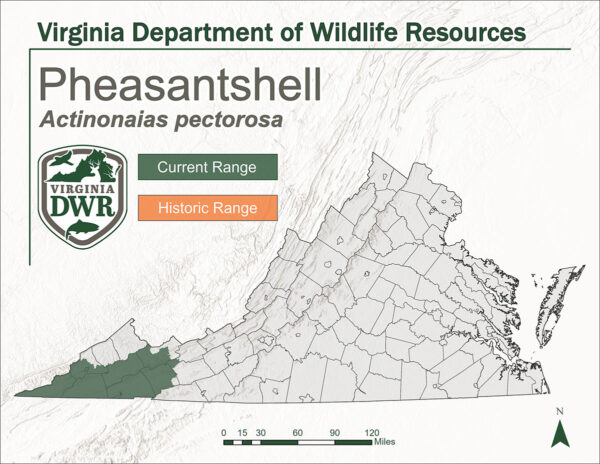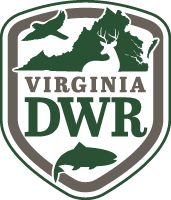A Pheasantshell measured during the annual Musselrama survey. Photo by ©Kayla Howard - DWR
Juvenile Pheasantshell propagated at the Freshwater Mollusk Conservation Center. Photo by ©Isabel Boyce
Adult Pheasantshell encountered during monitoring efforts. Photo by ©Kayla Howard - DWR
Fact File
Scientific Name: Lampsilis pectorosa
Classification: Freshwater Mussel, Family Unionidae
Conservation Status:
- Species of Greatest Conservation Need-Tier 3a on the Virginia Wildlife Action Plan
Size: 150 mm
Identifying Characteristics
- Shell is large, thick, and moderately inflated
- The anterior end is round, and the posterior end is bluntly pointed
- The ventral margin is straight or slightly curved
- The outer covering of the shell (periostracum) varies from yellowish-green to dark brown in color with faint, wide, broken green rays
- The inner portion of the shell (nacre) ranges from bluish-white to silver, some individuals may be pink
Habitat
The Pheasantshell inhabits shallow, fast-flowing riffles of small streams to large rivers. It prefers a stable substrate composition of mixed sand and gravel.
Distribution
The Pheasantshell occurs throughout the upper Tennessee River basin in southwest Virginia.

Life History
Freshwater mussels have a very unique life cycle. Parasitic larvae, called glochidia, develop in the gills of the female mussel. Once mature, the glochidia are expelled from the gills of the mussel and must attach to the gills of a suitable host fish, where they complete their transformation into a juvenile mussel. They then detach from the fish and begin their free-living existence on the river bottom.
Some freshwater mussels are host-specialists, meaning that metamorphosis can only occur on a limited number of closely related fish species, while others are host-generalists, with the ability to complete their life cycle using many different species. The Pheasantshell has a variety of suitable hosts including Banded Sculpin (Cottus carolinae), Black Bass (Micropterus spp.), Sauger (Sander canadensis), Walleye (Sander vitreus vitreus).
Conservation
The Pheasantshell has experienced dramatic population declines in the Tennessee portion of the Clinch River since 2016, when a mass die-off of freshwater mussels was first reported. The Pheasantshell is disproportionately affected during these die-offs, which occur annually, with up to 90% population loss estimated at shoals in Tennessee. However, Pheasantshell populations in Virginia remain large, as only the lowermost reach of the Clinch River is affected in the state.
Research into the cause of these die-offs and the pathology of freshwater mussels is ongoing, and both DWR’s Aquatic Wildlife Conservation Center (AWCC) and Virginia Tech’s Freshwater Mollusk Conservation Center (FMCC) continue to propagate and augment populations throughout its range. Additionally, long-term monitoring efforts carried out by DWR staff and partners throughout the upper Tennessee River basin helps to inform these conservation efforts by tracking population dynamics over time.
Special Considerations
Freshwater mussels are extremely imperiled organisms. DWR regulates the take and possession of freshwater mussels occurring within the state. It is unlawful to take mussels from any inland waters in the Commonwealth except as provided for in §§ 29.1-418 and 29.1-568 of the Code of Virginia.
Last updated: November 25, 2025
The Virginia Department of Wildlife Resources Species Profile Database serves as a repository of information for Virginia’s fish and wildlife species. The database is managed and curated by the Wildlife Information and Environmental Services (WIES) program. Species profile data, distribution information, and photography is generated by the Virginia Department of Wildlife Resources, State and Federal agencies, Collection Permittees, and other trusted partners. This product is not suitable for legal, engineering, or surveying use. The Virginia Department of Wildlife Resources does not accept responsibility for any missing data, inaccuracies, or other errors which may exist. In accordance with the terms of service for this product, you agree to this disclaimer.

